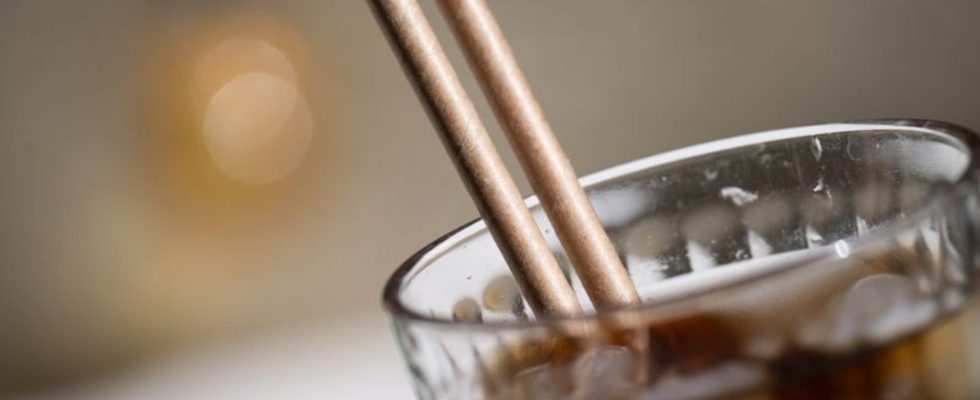consumer
Straws and disposable paper dishes often contain harmful substances
Instead of the banned plastic straws, many restaurants now have paper ones. photo
© Sebastian Christoph Gollnow/dpa
In order to do something good for the environment and your own health, many people are increasingly turning to products made of paper or bamboo when it comes to disposable tableware. But the supposedly better alternative is often not at all.
Instead of the banned plastic straws, many restaurants now have paper ones. However, they can for A research team in the journal “Food Additives & Contaminants: Part A” warns that the environment and health can also be harmful. Many supposedly environmentally friendly drinking straws made of paper or bamboo therefore contain long-lasting and potentially toxic chemicals, so-called PFAS. The sale of plastic drinking straws has been banned in the EU since July 3, 2021.
The group led by Thimo Groffen from the University of Antwerp examined drinking straws from 39 brands available in Belgium. PFAS were detected in 18 of 20 paper straws tested. The scientists also detected such substances in different amounts in four out of five bamboo straws, three out of four plastic straws and even in two out of five glass drinking straws. Only in straws made of stainless steel were no PFAS found.
From the straw to the drink
Using a special mass spectrometry method, the researchers found, among other things, trifluoroacetic acid and trifluoromethanesulfonic acid. “Both chemicals are readily soluble in water, so there is a risk that they will migrate from the straw into the drink,” the researchers explain. Whether and to what extent these and other PFAS are absorbed from drinking straws by humans must now be examined more closely.
PFAS – per- and polyfluorinated alkyl compounds – are used, among other things, to protect paper straws from getting soaked. The authors of the study emphasize that the potentially dangerous substances do not necessarily have to have been deliberately added during the manufacturing process. They could also get into the product through contaminated feedstock or process water.
“Straws made from plant-based materials like paper and bamboo are often advertised as more sustainable and environmentally friendly than those made from plastic,” Groffen said. “However, the presence of PFAS in these straws means that’s not necessarily true.” While small amounts of PFAS are not harmful in and of themselves, they can increase the chemical load already present in the body. “The most sustainable alternative seems to be stainless steel straws, which can be reused, contain no PFAS and can be fully recycled,” the team concludes.
A research team from the University of Gothenburg has been working on paper cups as a replacement for single-use plastic cups. Since paper is neither grease nor water resistant, it must be provided with a surface coating if it is to be used as a packaging material for food. This plastic film often consists of polylactide (PLA), a type of bioplastic made from renewable raw materials such as corn.
Microplastics from bioplastics
In the study presented in the journal “Environmental Pollution”, the team led by Bethanie Carney Almroth exposed mosquito larvae of the species Chironomus riparius to water and sediment in which parts of cups and lids made of polypropylene or polystyrene as well as polylactide and paper had been lying for one to four weeks . Chironomus riparius is therefore a model species for toxicological studies and represents an important group of aquatic organisms that are of crucial importance for ecosystems. “All the cups had a negative effect on the growth of the mosquito larvae,” said Carney Almroth.
Various harmful substances are released from the material into the environment. “Paper-based food packaging can contain high amounts of per- and polyfluorinated alkyl compounds,” the study states, among other things. The longer the material had been in the water or sediment, the greater the effect. “Bioplastics contain at least as many chemicals as conventional plastics,” said Carney Almroth. In addition, bioplastics do not degrade effectively, and the resulting microplastics are ingested by living beings, just like other plastics.
“Paper packaging also poses a potential health risk compared to other materials, and its use is increasing,” emphasized the scientist. After the Second World War, disposable products came onto the market and were advertised in large campaigns – humanity must now get away from this wrong path. It is important to say goodbye to the throwaway lifestyle – for the environment and for your own health.
Many PFAS persistent and hardly degradable
PFAS are man-made chemicals that have many uses. They make textiles breathable and water-repellent, paper dirt, grease and water-repellent and improve the spreading properties of fire-fighting foam. PFAS are also sometimes used in food packaging.
Because many PFAS are very persistent and hardly degradable, they are also called perpetuity chemicals. They accumulate more and more in the environment. PFAS are linked to various health problems, including lower birth weight in infants, thyroid disease, high cholesterol, liver damage, and kidney and testicular cancer.
Some PFAS are already largely banned because they are considered dangerous. ‘Of the relatively few well-studied PFAS, most are considered to be moderately to highly toxic, particularly to child development,’ says the European Environment Agency (EEA). It is not yet known how the vast majority of PFAS affect people and the environment. Many professionals assume that at least part of it has negative properties.

